Manners, Customs, Clothing
 |
 |
 |
 |
 |
 |
 |
The Catholic Approach to Hiking - 3
Dressing with Dignity on Excursions
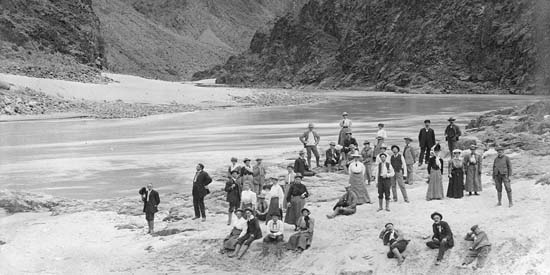
Hiking in the Grand Canyon in the 1900s
Today, most people make no special efforts to dress well when hiking. They put on the random T-shirt and shorts (or jeans or leggings) that first come into their grasp.
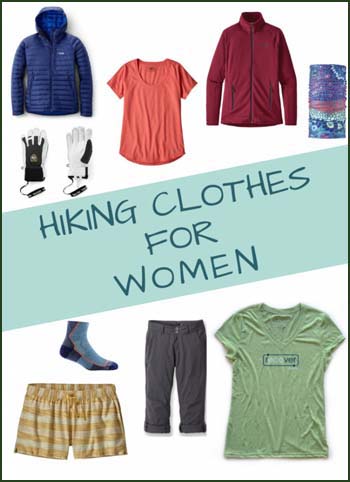
Modern hiking: Keep it simple, casual, immodest
A short walk through a store that specializes in hiking clothing confirms these principles: One may choose from an assortment of flimsy or thin artificial pants, shorts, and shirts for both sexes (if there are skirts or dresses for women, they are short or sheer). Modesty is certainly not a virtue that comes to mind when browsing these clothes. Nor is there anything at all attractive about the styles: The aims are practicality, comfort and speed.
This mentality reflected in modern hiking clothing is contrary to all the good customs of the past. Let us take a brief journey through the ages to see the manner of hiking clothing that was prevalent in the past.
Hiking with customary decorum
In the Middle Ages, as we saw in my past articles (here and here), hiking was a very natural activity of daily life. Therefore, the daily clothing was in itself perfectly suitable for walking. The medieval man simply wore his normal clothing, usually with an added cloak for warmth and protection against the elements. Women who traveled would likewise wear their customary long dresses with a cape or mantel. (1)
In these times, all clothing were made of durable natural materials, predominantly wool and linen, which could withstand stains and tears. It was understood that it was important to be modestly clothed with dignity at all times due to the presence of God and the Angels.
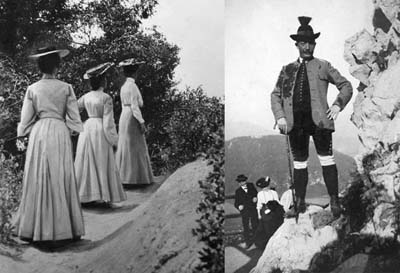
Edwardian ladies hiking, right, a German man enjoying nature; below, a Victorian family on a snow trek
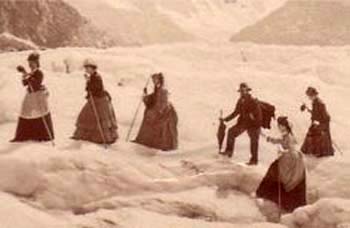
These dignified men and women did not complain about being uncomfortable or too hot as the modern hiker is wont to do despite the lightweight clothing designed to prevent such grievances. Their healthy vitality and orderly appearance is a proof to the modern man and woman that it is possible to hike – even on very difficult terrains – fully clothed with dignity.
The longing for adventure, however, began to call to women, who were cultivating the taste of freedom from the "confines of the home." The Revolution could not leave the good movement of enjoying the natural world untouched, for it was there that the seeds of feminism were planted.
Thus, even in the 19th century, women began to don trousers in order to engage in more arduous hiking activities, or simply because it was easier to walk in pants than long skirts. Hiking became a way to liberate women and prove that they were just as strong as men (a fallacy still shown to be false – take for instance, the women’s vs the men’s Olympics).
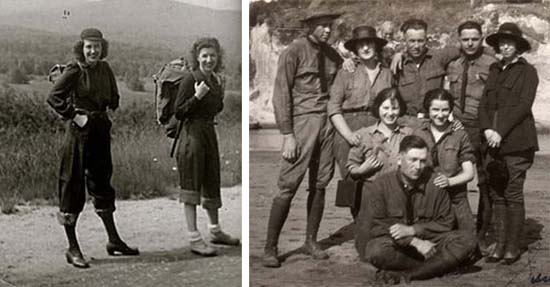
Liberated women join men in their knickerbockers
However, pants for woman did not immediately become publicly acceptable on trails. The change had to be wrought gradually in order to slowly break a woman’s sense of modesty. In the mid-1890s, the common hiking apparel recommended by many magazines was a “biking ensemble” of a shorter skirt reaching to the top of the boot with bloomers or knickerbockers underneath. Oftentimes, the knickerbockers or bloomers showed from underneath the skirt – making it less of an undergarment and more of an article of clothing.
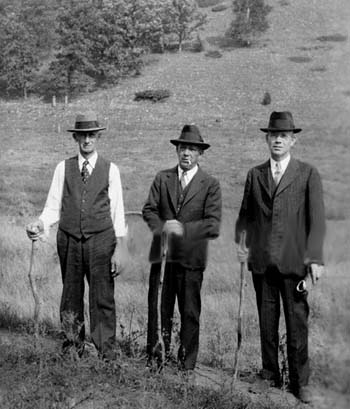
From this above... to this below... in a very short time
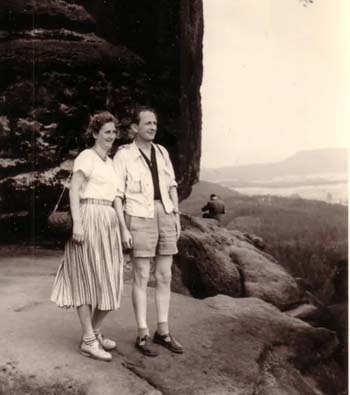
By the early 1900’s, independent female adventurers advocated for the complete abandonment of skirts on the trail; for, these liberated women argued, skirts were a foolish hindrance to movement and comfort. Even some male writers took up the cause for trousers or knickerbrockers, such as William J. Whiting, who stated in the Outing sports magazine in 1916:
“The skirt is useless, is in fact a positive hindrance, and so by its very presence calls attention to the fact that she is a woman, and modest, or trying to be, thus defeating its object. Anyone who has seen an emancipated woman dancing over rough trails in glee at her freedom … with no useless freak of costume to call attention to her femininity rejoices that so many now recognize that immodesty of attire is really unsuitability.” (4)
Eventually the revolutionaries prevailed: It became universal for women to don trousers when hiking. And as women’s hiking clothing became more casual, the men’s clothing followed suit, although it did so less gradually.
For, why should the men have to wear the added layer of a coat or jacket if women could abandon their skirts and don informal attire that in many cases was more casual than their own? If women could dress like boys, why could the men not do the same?
The complete egalitarianism in dress could only take place if the men adopted the casual boy's apparel the women were wearing. This was accomplished when the men began to wear knickerbockers (large puffy pants that ended just below the knee) with socks on hiking excursions in the late 1800’s and early 1900’s.
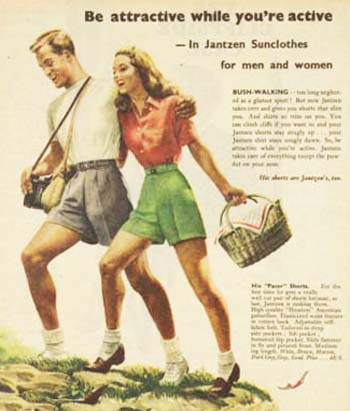
By the 1950s egalitarianism in dress had conquered
Here I note that it is not my intention to condemn all knickerbockers for men of different cultures or different time periods; in many instances the use of knickerbockers was charming. I mean only to analyze why they were adopted at this time for hiking in the Western world. In this case, it was a style initiated by the Revolution to break the idea of dressing with dignity. The women dressed like boys and the men joined them in their casual degradation, further shortening the gap between men’s and women’s clothing. (5)
So then, if men and women can wear knickerbockers, what is to stop them from wearing shorts? This is indeed what happened in the 1930’s, along with a variety of other more casual styles such as short-sleeved, open-collared shirts, which became acceptable for men and women. By the 1950’s such clothing, with even less decorum, had become common.
Countering the anything-goes attitude
And so we come to the modern era of hiking clothing where anything goes. Anything, that is, except that which is modest, beautiful and refined.
As counter-revolutionaries, it is our duty to counter the modern spirit of casualness and egalitarianism. We must do this even when engaging in such activities as hiking and not only when in public places.
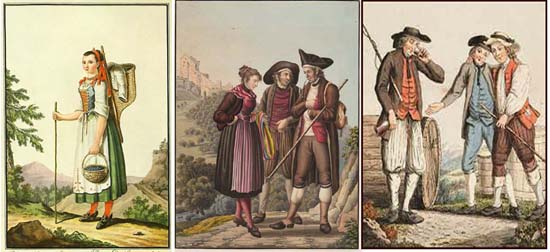
Hikers of the past: a German peasant girl; Swiss hikers: bougeousie & peasants
The objection rises: The old-fashioned sturdy clothing of the past is not easy to find these days, so what are we to wear?
Practically speaking, the best materials to wear when hiking are materials that dry quickly and do not soak up moisture, such as wool and linen. Cotton is not a good choice of fabric, because it absorbs moisture. Although these materials may be more expensive to purchase, they will last far longer than any artificial fabric and are much better for one’s skin.
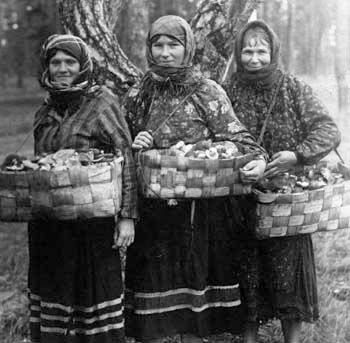
Russian peasants in the woods collecting mushrooms
Women should strive to find feminine dresses or blouses to accompany their skirts to counter the revolutionary tendency to dress in a more masculine manner. Men should strive to be fully clothed with long sleeves, long pants and an added necktie of some sort, or at least a shirt buttoned to the neck to protest and counter the indecency of many men who hike without even a shirt covering themselves.
Both men and women should wear socks or stockings, preferably wool, with shoes or boots that do not draw attention to themselves as the clownish modern tennis shoes do. Hats are a practical added accessory that can also help to add decorum to a hiking outfit.
It is best to take inspiration from the past when assembling an appropriate ensemble. The pictures in this article can be a basis for ideas.
This article on men’s hunting attire in England may also be of some help to the men when deciding what to wear, although some of the recommendations in the article do not apply to hiking.
It may take an extra effort to find clothing that is suitable for a day of dignified hiking, but, even if the clothing you find is not perfect, it will be a step in the right direction. Every little effort we make to counter the revolution in dress is one step closer to the Reign of Mary.
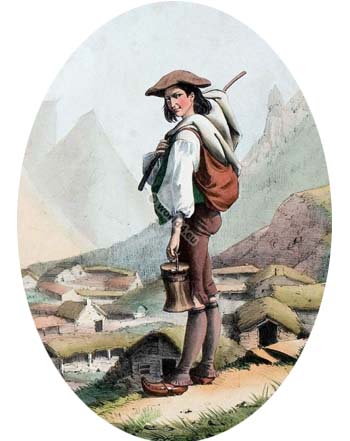
Works cited:
- https://thevintagetraveler.wordpress.com/tag/hiking-clothing/
- https://vintagedancer.com/vintage/vintage-hiking-camping-clothes/
- https://www.nps.gov/klgo/learn/historyculture/victorianage.htm
- https://weareexplorers.co/history-hiking-clothing/
- http://hikinginthesmokys.blogspot.com/2018/11/the-true-realities-of-womens-hiking.html
Posted February 14, 2022
______________________
______________________





